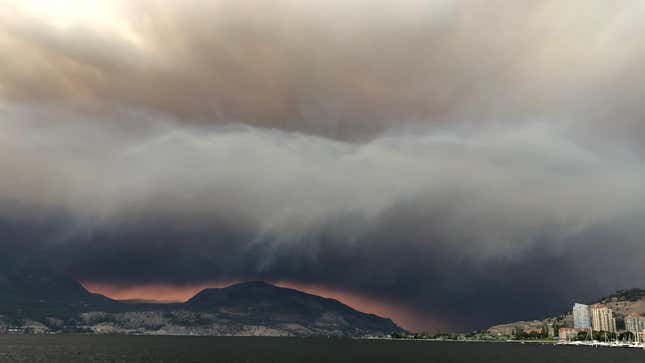
The Canadian province of British Columbia is on fire. Hundreds of fires are burning out of control across the region, and smoke from the blazes is turning the skies black in the middle of the day.
Shocking photos emerged from across the province of people driving with their headlights on in as inky blackness descended from thick smoke. Vicki Komisar, an assistant professor in the school of engineering at the University of British Columbia, was at City Park in the middle of the city of Kelowna on Sunday. The sky was so dark that it looked like the sun was setting. She snapped the photo above of the sky from the park.
“I would liken the experience to standing at the gates of hell,” she said in a Twitter direct message, likening the sight of the orange flames to “impending, multiple apocalypses.”
Some 270 active wildfires are blazing in the province and have burned nearly 1.7 million acres so far this fire season. That’s an area larger than the city of Toronto. It’s the worst fire period the province has seen since 2018 when similarly catastrophic conditions did the whole horrible day into night thing.
On Monday, strong winds exacerbated the flames even further as thousands remain under evacuations orders. Gusts from the southwest are spreading the fire’s smoke far and wide, and several cities are experiencing dangerously poor air quality due to the pollution. More than 3,000 firefighters and other workers are working to battle the flames.

Fires are also blazing through the neighboring province of Alberta. According to Swiss company IQAir, two southern Alberta towns, Kananaskis and Canmore, are currently breathing in the worst air quality in the nation. Western Ontario and parts of Manitoba have also seen monster fires in what has been a season of smoke across the country.
Canada has already exceeded its 10-year annual fire average by at least 30%, according to Natural Resources Canada. And that’s with months left in the fire season. Temperatures in British Columbia could climb past 90 degrees Fahrenheit (32 degrees Celsius) this week, which could further parch the dry land and make it all the more difficult to stop the flames from spreading.
Earlier this summer, Canadian wildfires burned down an entire British Columbia town and sparked firestorms that created 710,117 lightning bolts, which is 5% of all of Canada’s lightning in an average year. This is all the more evidence that climate breakdown isn’t waiting for us in the distant future. It’s already here.